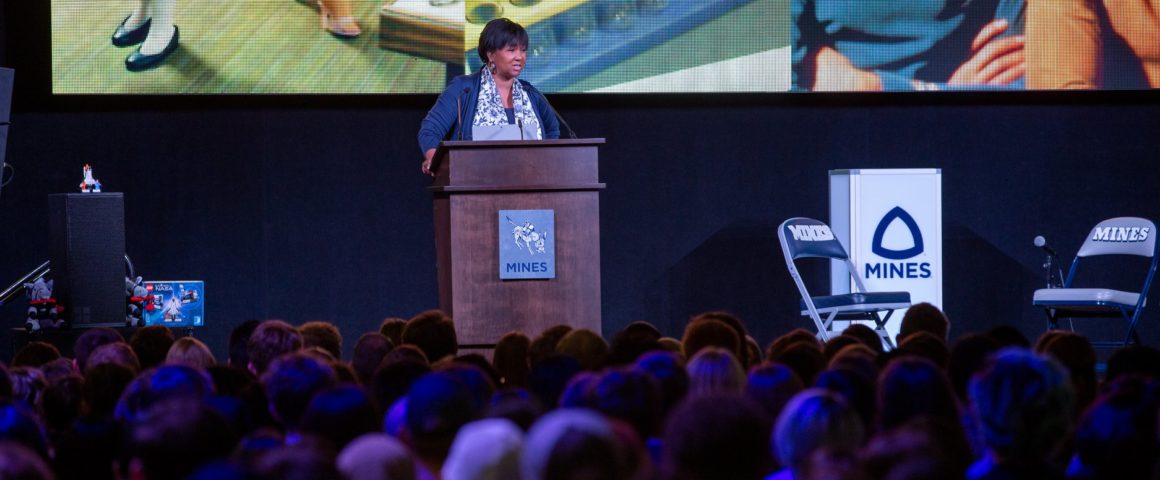Fellow Orediggers, once again Homecoming has come and gone during which we hopefully got to celebrate being half way through the semester (with our equally exhausted peers) and attend exciting events that didn’t make our wallets sad. In the spirit of any good Mines student, we were also ecstatic to welcome our world-renowned Homecoming Distinguished Lecturer, Dr. Mae Jemison, to campus to speak to us on outer space, looking up at the sky, and how we all can help bring a new generation of innovation into the world. Some people may think we’re crazy for highlighting a lecture as one of our most “popping” events during any given homecoming weekend, but once again, our lecturer proved up to the task of helping students procrastinate on their homework in favor of even more actual learning (if only we could make physics lectures that tempting to attend…).
Before Dr. Jemison came up to speak before the school, she held a small meet and greet with a group of selected students from different organizations across campus to answer questions and simply talk. From the moment she walked in the room, she asked everyone to come as close as they could to make the whole event seem more personal and then asked individual students why they wanted to meet her. From people who had learned about her in school and looked up to her work as a scientist to people who saw how she became the first female African American astronaut in space to one student who had a personal connection to her work with the Peace Corps early in her career, there didn’t seem to be any aspect of life that Mae Jemison hadn’t impacted in some way for the students who went to speak with her. One student even brought a lego set with Mae in lego form – something that brought a huge smile to her face. During this time, students were also able to ask more personal questions about how she got to where she was today and just how becoming an astronaut has always been in her mind’s eye. We also learned that one of the primary reasons she chose to go to Stanford was because they had won the Rose Bowl a few years prior, a perfectly valid reason. [This makes me wonder – if a good football team is any indicator for innovative thinkers in science attending a university, then looking at the Oredigger’s season so far, we should have an amazing first year class coming in soon!]
After the individual event, the main lecture took place in Lockridge Arena where hundreds of students greeted Dr. Jemison as she entered. This just moments after the Mines Interhouse Team was honored by President Paul Johnson for their international win in Morocco. Greeted with loud cheers and stomps (and this was before we knew it was her birthday!), Dr. Jemison began to present to the student body about her personal philosophy that innovation is everywhere but it starts by looking up. Most of her initiatives (once she got back to Earth after floating around in space for a while) have focused on making sure that no matter what is happening down here on the ground, space research will keep progressing. Even though there is some argument for focusing on things “relevant” to us here on Earth, Dr. Jemison argued that some of the greatest innovations used on Earth have come from research done with space travel. She was engaging and personally excited as she spoke about how interstellar travel is the next great step for us as engineers and scientists and the task for us to encourage the next generation – and hey, if we can make Star Trek a reality, even better. She asked some hard-hitting questions, like if we were to travel across galaxies, could we do it as vegetarians? Or without coffee or chocolate? Or would we even want to be awake for it (a question that was immediately defended by a student in the back who argued “All movies with any form of suspended animation for space travel end badly”)? These are all things we will need to consider as we move forward in science and space travel.
However, until then, Dr. Jemison simply asks us to be aware of how what we do impacts everyone as we remember we are all #TeamEarthlings. In her own words, “It doesn’t mean that you don’t push for the extraordinary, but you know, we all get to make choices. There’s something missing as we pursue excellence as individuals and as organizations and we don’t understand that we’re connected across space and time to people who came before us and to people who are in the world with us now and people who are in the world with us afterwards.” Together, we can make amazing things happen – across all levels of science, all forms of education, and all types of challenges. Keep innovating Mines and remember, civils may build the targets for the mechanicals – but we like watching things blow up too.


'Looking Up — We Mean Back — at Homecoming 2019 with Mae' has no comments
Be the first to comment this post!